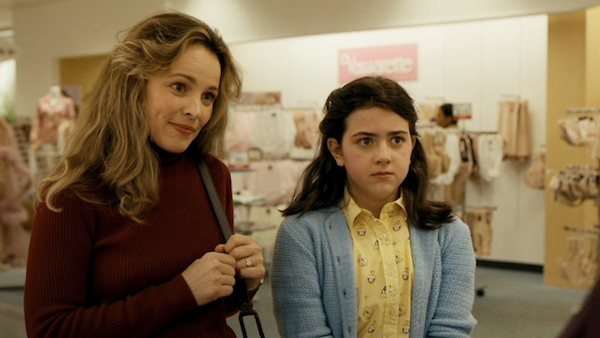Movie review by Greg Carlson
Although not quite as good as feature directorial debut “The Edge of Seventeen,” Kelly Fremon Craig’s adaptation of Judy Blume’s classic 1970 novel makes for an admirable and satisfying big screen companion piece. Veteran kid actor Abby Ryder Fortson leads an ensemble that includes Rachel McAdams, Kathy Bates, and Benny Safdie as the core members of the Simon family. While Blume’s frank address of topics including menstruation and the physical changes accompanying puberty continue to drive critical discussion of the story, Margaret’s struggle to understand the liminal place between her mother’s Christianity and her father’s Judaism is equally important.
Fremon Craig also wrote the screenplay, which preserves some of Blume’s dialogue verbatim while updating and expanding other aspects of the beloved novel. The movie uses the book’s period setting, but aside from some clothing choices and several vintage needle-drops – including “Son of a Preacher Man,” “Jump in the Line,” “These Eyes,” “Signed, Sealed, Delivered (I’m Yours),” and the reliable “Spirit in the Sky” – the overall mise en scene reads as wholly contemporary. The resulting timelessness invites several generations of readers to easily project themselves into the action.
The most devoted Blume fans should appreciate Fremon Craig’s spiritual fealty to the source material, even if some details are missing and other dimensions are altered. The after-school club of girls Margaret joins is not identified as the Pre-Teen Sensations, but the famous bust-building exercise and accompanying chant (which Blume, who very briefly appears in an unrelated, non-speaking cameo, demonstrated when it was being rehearsed “incorrectly” on set) occupies its rightful place. One of the most significant alterations is the welcome expansion of business and agency for Margaret’s mom Barbara, whose own adjustments to suburban life and desire to fit in with peers parallel some of her daughter’s worries.
Despite the film’s PG-13 rating, “Are You There God? It’s Me, Margaret.” has an overwhelmingly wholesome glow. That’s not to say Fremon Craig downplays the many ways in which girls on the cusp of adolescence can wield cruelty as a defense against confusion and uncertainty. In one of the best scenes in the novel, the physically mature Laura Danker confronts Margaret, asking, “Do you think it’s any fun to be the biggest kid in the class?” In the movie, Fremon Craig makes what I think is a good choice to reimagine the end of Danker’s small arc, even if it softens Blume’s edges.
Indebted to Blume, Fremon Craig’s thematic emphasis on womanhood charts our course through the film. Marya E. Gates points out that we see “not just a coming-of-age story but also a deeper examination of the sacrifices, trauma, and safety that women can find while building their own families.” Melena Ryzik writes about the movie’s intersection with religious freedom and bodily autonomy in light of current politics: “An era in which girls and women were held in an information vacuum — about their own bodies! — seems dangerously close to being resurrected.” More than five decades after we first met eternal sixth-grader Margaret, we need her more than ever.
